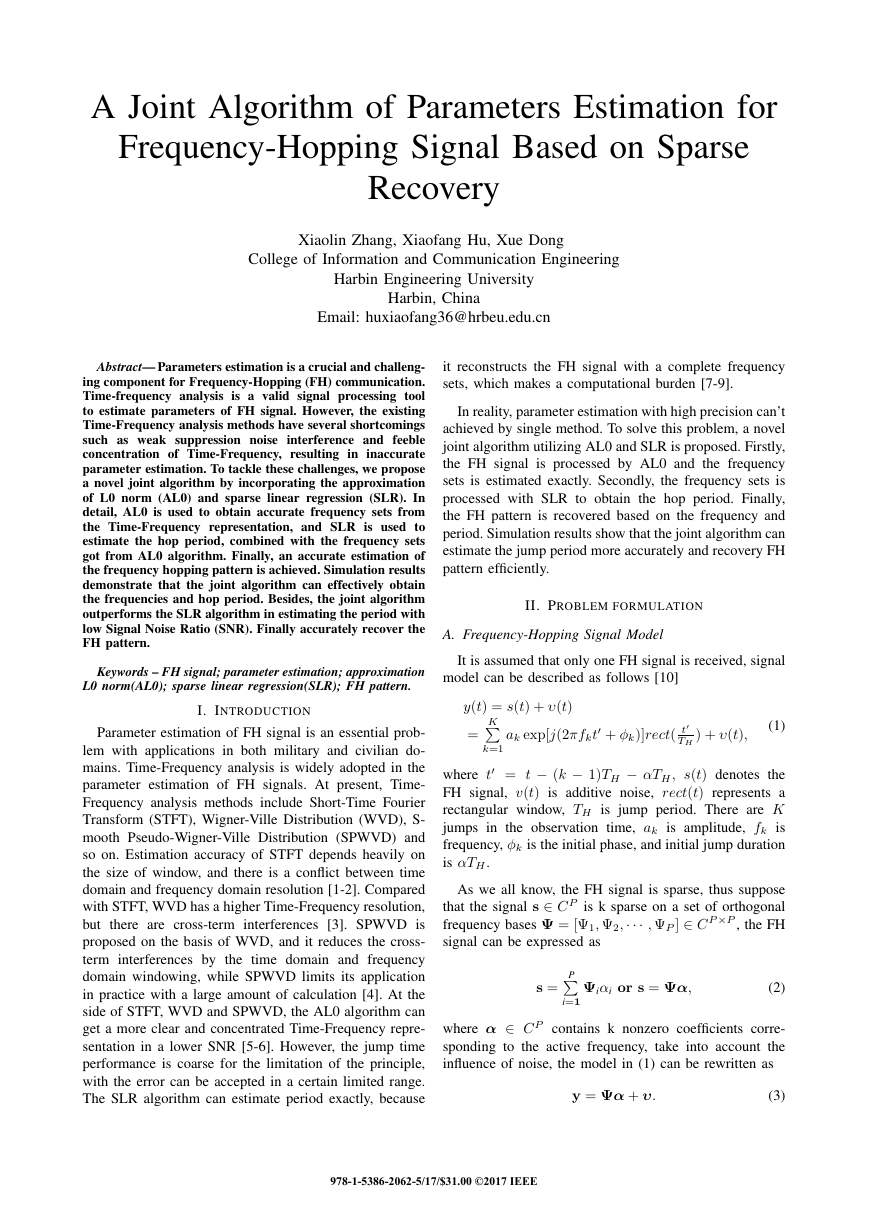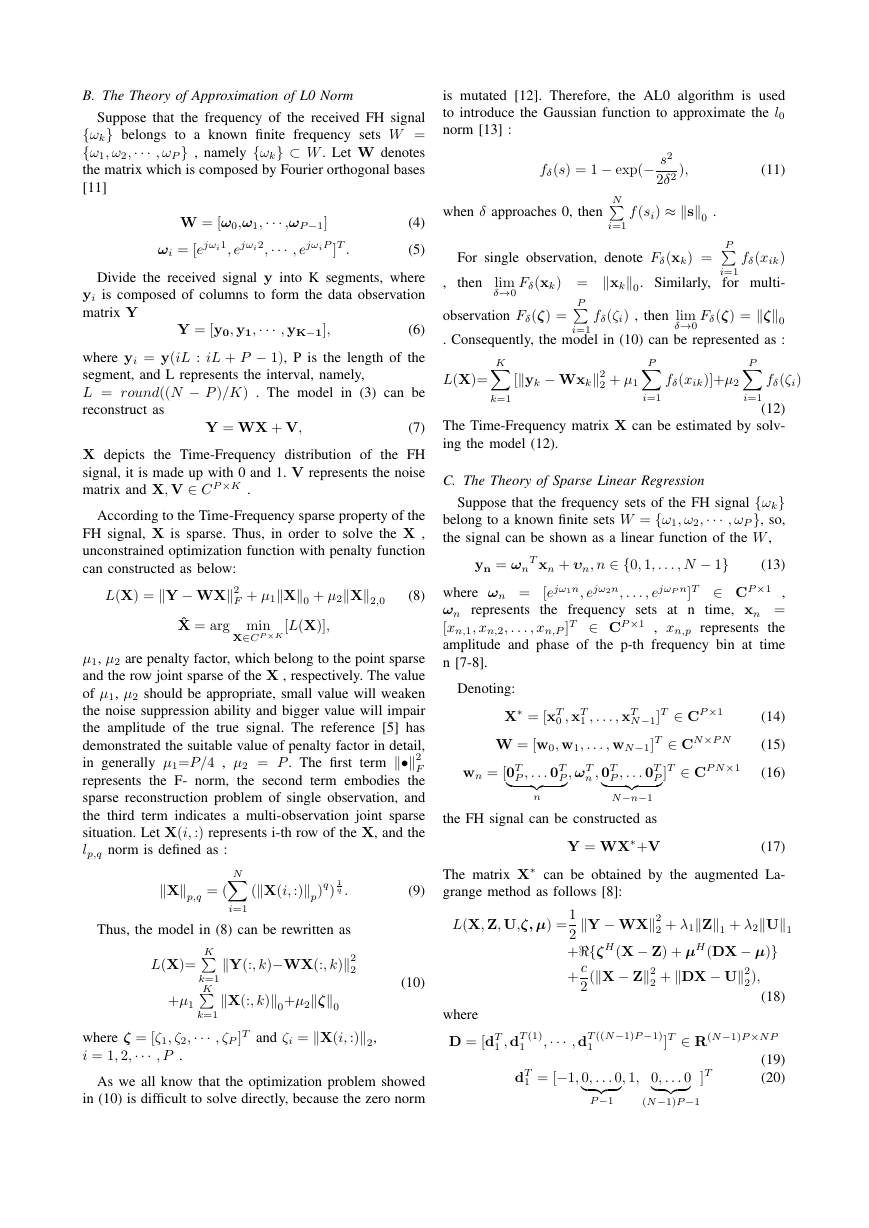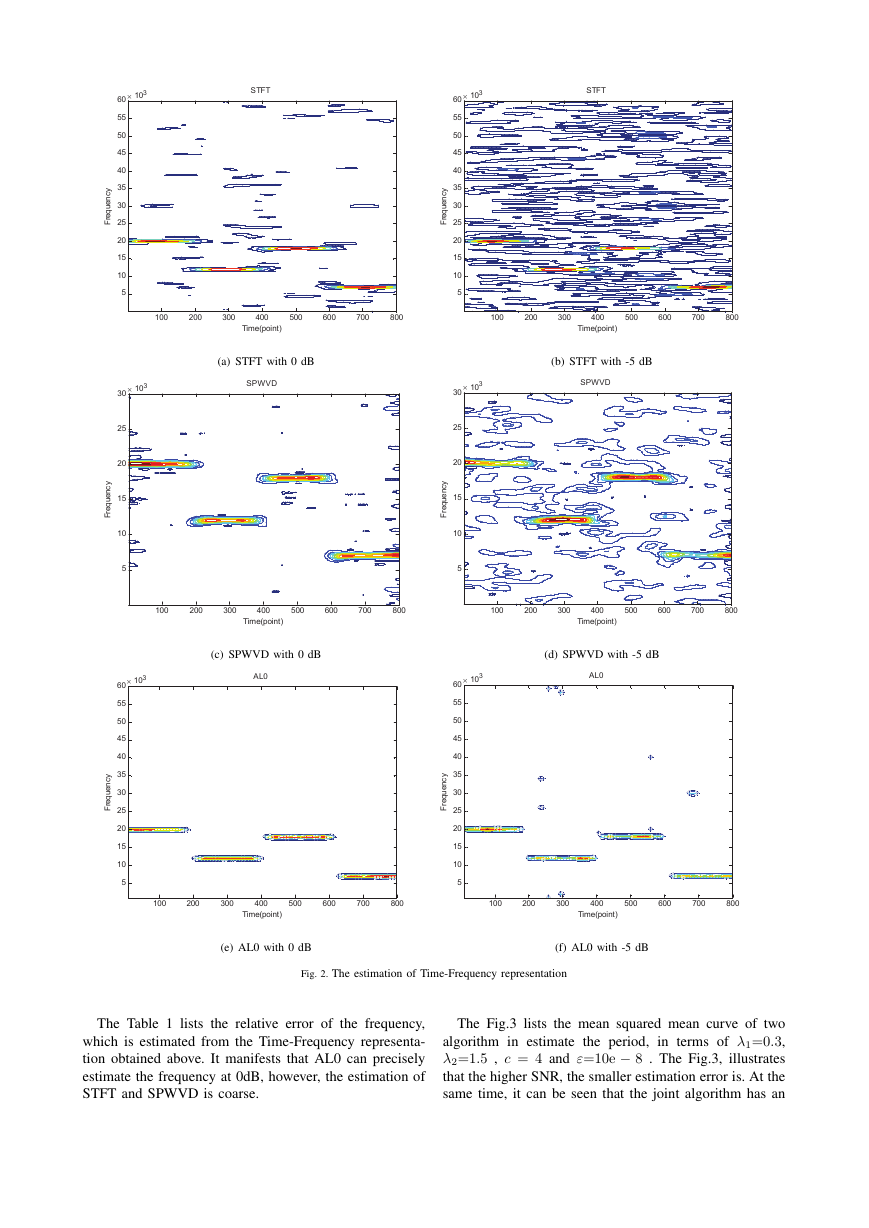A Joint Algorithm of Parameters Estimation for
Frequency-Hopping Signal Based on Sparse
Recovery
Xiaolin Zhang, Xiaofang Hu, Xue Dong
College of Information and Communication Engineering
Harbin Engineering University
Harbin, China
Email: huxiaofang36@hrbeu.edu.cn
Abstract— Parameters estimation is a crucial and challeng-
ing component for Frequency-Hopping (FH) communication.
Time-frequency analysis is a valid signal processing tool
to estimate parameters of FH signal. However, the existing
Time-Frequency analysis methods have several shortcomings
such as weak suppression noise interference and feeble
concentration of Time-Frequency, resulting in inaccurate
parameter estimation. To tackle these challenges, we propose
a novel joint algorithm by incorporating the approximation
of L0 norm (AL0) and sparse linear regression (SLR). In
detail, AL0 is used to obtain accurate frequency sets from
the Time-Frequency representation, and SLR is used to
estimate the hop period, combined with the frequency sets
got from AL0 algorithm. Finally, an accurate estimation of
the frequency hopping pattern is achieved. Simulation results
demonstrate that the joint algorithm can effectively obtain
the frequencies and hop period. Besides, the joint algorithm
outperforms the SLR algorithm in estimating the period with
low Signal Noise Ratio (SNR). Finally accurately recover the
FH pattern.
Keywords – FH signal; parameter estimation; approximation
L0 norm(AL0); sparse linear regression(SLR); FH pattern.
I. INTRODUCTION
Parameter estimation of FH signal is an essential prob-
lem with applications in both military and civilian do-
mains. Time-Frequency analysis is widely adopted in the
parameter estimation of FH signals. At present, Time-
Frequency analysis methods include Short-Time Fourier
Transform (STFT), Wigner-Ville Distribution (WVD), S-
mooth Pseudo-Wigner-Ville Distribution (SPWVD) and
so on. Estimation accuracy of STFT depends heavily on
the size of window, and there is a conflict between time
domain and frequency domain resolution [1-2]. Compared
with STFT, WVD has a higher Time-Frequency resolution,
but
there are cross-term interferences [3]. SPWVD is
proposed on the basis of WVD, and it reduces the cross-
term interferences by the time domain and frequency
domain windowing, while SPWVD limits its application
in practice with a large amount of calculation [4]. At the
side of STFT, WVD and SPWVD, the AL0 algorithm can
get a more clear and concentrated Time-Frequency repre-
sentation in a lower SNR [5-6]. However, the jump time
performance is coarse for the limitation of the principle,
with the error can be accepted in a certain limited range.
The SLR algorithm can estimate period exactly, because
it reconstructs the FH signal with a complete frequency
sets, which makes a computational burden [7-9].
In reality, parameter estimation with high precision can’t
achieved by single method. To solve this problem, a novel
joint algorithm utilizing AL0 and SLR is proposed. Firstly,
the FH signal is processed by AL0 and the frequency
sets is estimated exactly. Secondly, the frequency sets is
processed with SLR to obtain the hop period. Finally,
the FH pattern is recovered based on the frequency and
period. Simulation results show that the joint algorithm can
estimate the jump period more accurately and recovery FH
pattern efficiently.
II. PROBLEM FORMULATION
A. Frequency-Hopping Signal Model
It is assumed that only one FH signal is received, signal
model can be described as follows [10]
y(t) = s(t) + υ(t)
K
=
k=1
(1)
TH ) + υ(t),
+ φk)]rect( t
ak exp[j(2πfkt
= t − (k − 1)TH − αTH , s(t) denotes the
where t
FH signal, v(t) is additive noise, rect(t) represents a
rectangular window, TH is jump period. There are K
jumps in the observation time, ak is amplitude, fk is
frequency, φk is the initial phase, and initial jump duration
is αTH.
As we all know, the FH signal is sparse, thus suppose
that the signal s ∈ C P is k sparse on a set of orthogonal
frequency bases Ψ = [Ψ1, Ψ2,··· , ΨP ] ∈ C P×P , the FH
signal can be expressed as
P
i=1
s =
Ψiαi or s = Ψα,
(2)
where α ∈ C P contains k nonzero coefficients corre-
sponding to the active frequency, take into account the
influence of noise, the model in (1) can be rewritten as
y = Ψα + υ.
(3)
978-1-5386-2062-5/17/$31.00 ©2017 IEEE
�
is mutated [12]. Therefore, the AL0 algorithm is used
to introduce the Gaussian function to approximate the l0
norm [13] :
fδ(s) = 1 − exp(− s2
2δ2 ),
(11)
when δ approaches 0, then
f (si) ≈ s0 .
N
i=1
P
,
For single observation, denote Fδ(xk) =
Fδ(xk) = xk0. Similarly,
then lim
δ→0
fδ(xik)
i=1
for multi-
Fδ(ζ) = ζ0
observation Fδ(ζ) =
. Consequently, the model in (10) can be represented as :
fδ(ζi) , then lim
δ→0
P
i=1
L(X)=
[yk − Wxk2
2 + μ1
fδ(xik)]+μ2
fδ(ζi)
P
i=1
P
i=1
K
k=1
(7)
(12)
The Time-Frequency matrix X can be estimated by solv-
ing the model (12).
B. The Theory of Approximation of L0 Norm
Suppose that the frequency of the received FH signal
{ωk} belongs to a known finite frequency sets W =
{ω1, ω2,··· , ωP} , namely {ωk} ⊂ W . Let W denotes
the matrix which is composed by Fourier orthogonal bases
[11]
W = [ω0,ω1,··· ,ωP−1]
ωi = [ejωi1, ejωi2,··· , ejωiP
T .
]
(4)
(5)
Divide the received signal y into K segments, where
yi is composed of columns to form the data observation
matrix Y
Y = [y0, y1,··· , yK−1],
(6)
where yi = y(iL : iL + P − 1), P is the length of the
segment, and L represents the interval, namely,
L = round((N − P )/K) . The model in (3) can be
reconstruct as
Y = WX + V,
X depicts the Time-Frequency distribution of the FH
signal, it is made up with 0 and 1. V represents the noise
matrix and X, V ∈ C P×K .
According to the Time-Frequency sparse property of the
FH signal, X is sparse. Thus, in order to solve the X ,
unconstrained optimization function with penalty function
can constructed as below:
L(X) = Y − WX2
F + μ1X0 + μ2X2,0
(8)
ˆX = arg min
X∈CP×K
[L(X)],
μ1, μ2 are penalty factor, which belong to the point sparse
and the row joint sparse of the X , respectively. The value
of μ1, μ2 should be appropriate, small value will weaken
the noise suppression ability and bigger value will impair
the amplitude of the true signal. The reference [5] has
demonstrated the suitable value of penalty factor in detail,
in generally μ1=P/4 , μ2 = P . The first term •2
F
represents the F- norm, the second term embodies the
sparse reconstruction problem of single observation, and
the third term indicates a multi-observation joint sparse
situation. Let X(i, :) represents i-th row of the X, and the
lp,q norm is defined as :
Xp,q = (
K
K
Thus, the model in (8) can be rewritten as
Y(:, k)−WX(:, k)2
X(:, k)0+μ2ζ0
(X(i, :)p)
N
L(X)=
+μ1
(10)
(9)
k=1
i=1
q .
)
2
q
1
k=1
where ζ = [ζ1, ζ2,··· , ζP ]T and ζi = X(i, :)2,
i = 1, 2,··· , P .
As we all know that the optimization problem showed
in (10) is difficult to solve directly, because the zero norm
C. The Theory of Sparse Linear Regression
Suppose that the frequency sets of the FH signal {ωk}
belong to a known finite sets W = {ω1, ω2,··· , ωP}, so,
the signal can be shown as a linear function of the W ,
yn = ωn
T xn + υn, n ∈ {0, 1, . . . , N − 1}
(13)
where ωn = [ejω1n, ejω2n, . . . , ejωP n]T ∈ CP×1 ,
ωn represents the frequency sets at n time, xn =
[xn,1, xn,2, . . . , xn,P ]T ∈ CP×1 , xn,p represents the
amplitude and phase of the p-th frequency bin at time
n [7-8].
Denoting:
X∗
0 , xT
= [xT
1 , . . . , xT
T ∈ CP×1
N−1]
T ∈ CN×P N
W = [w0, w1, . . . , wN−1]
T ∈ CP N×1
P , . . . 0T
P
N−n−1
the FH signal can be constructed as
wn = [0T
P , . . . 0T
P
n , 0T
, ωT
n
]
(14)
(15)
(16)
Y = WX∗
(17)
The matrix X∗ can be obtained by the augmented La-
grange method as follows [8]:
+V
L(X, Z, U,ζ, μ) =
2 + λ1Z1 + λ2U1
(DX − μ)}
(X − Z) + μH
Y − WX2
1
2
+{ζH
c
+
(X − Z2
2 + DX − U2
2),
2
(18)
where
D = [dT
1 , dT (1)
1
,··· , dT ((N−1)P−1)
1
1 = [−1, 0, . . . 0
dT
P−1
, 1, 0, . . . 0
(N−1)P−1
]
T ∈ R(N−1)P×N P
(19)
(20)
T
]
�
Fig. 1. Process diagram of Frequency-Hopping signal
The (•)m represents the right cyclic shift of m position.
ζ, μ are Lagrange multipliers, coefficient matrix X can
be estimated by solving the equation (18).
A. Parameters Estimation Scheme of Frequency-Hopping
Signal
We have learnt that the SLR algorithm can estimate
period exactly with a complete frequency sets, which
makes a computational burden. It’s worth mentioning that
AL0 algorithm can precisely estimate the frequency with a
relatively smaller amount of calculation. In view of this, a
now joint algorithm is proposed and the estimation scheme
of FH pattern can be described as Fig.1.
B. The Process to Obtain Time-Frequency Matrix in Ap-
proximation of L0 Norm Algorithm
In this paper, the steepest descent algorithm is used
to solve the X . The steepest descent direction is the
conjugate gradient direction of the objective function. The
conjugate gradient of model (12) is
∇L(X) = WH
μ2Λ2X
(21)
(x) = exp(− x2
where, Λ1 = fδ
2δ2 )
, Λ2 is a diagonal matrix, whose diagonal element is
exp(−X(n, :)2
2 /2δ2)/δ2, X(n, :) represents the n-th
row of the matrix.
(WX − Y) +
μ1Λ1• ∗ X +
(X)/δ2 , and fδ
1
2
1
2
The AL0 algorithm can be divided into the following
−1Y ;
steps:
1. The initial value of X is X(0)=WT(WWT)
III. JOINT ALGORITHM
μ(i)
2. Select a set of descending sequence [δ1, δ2,··· , δJ ]
[13], the convergence criterion is ε ;
3. Denote δ = δj and j = 1, 2,··· , J , the algorithm
iterates over the following steps:
1) Determine the step size u
Lδ(X − u∇L(X)) < Lδ(X) temp1 = norm(X).
2) Descend in the gradient direction
X = X − u∇L(X) temp2 = norm(X)
3) The iteration termination condition
if dif f (abs(temp2 − temp1)) < ε , execute X(j) = X
4) Output the results ˆX = X(J) .
C. The Process to Obtain Time-Frequency Matrix in S-
parse Linear Regression Algorithm
In this paper, we use the alternating direction method
of multipliers (ADMOM) method to solve the (18) to get
X , and the ADMOM iterates over the following steps
(WH Y − ζ(i−1)
=(WHW + cDH D + cINP)
X(i)
−1
− DH μ(i−1)
+ cZ(i−1)
Z(i)
= shrink(X(i)
+
U(i)
= shrink(DX(i)
+ cDH U(i−1)
ζ(i−1)
,
λ1
c )
c
μ(i−1)
)
(22)
(23)
(24)
(25)
(26)
λ2
c )
).
c
+
,
+ c(X(i) − Z(i)
)
+ c(DX(i) − U(i)
, Z(0)
2
ζ(i)
= ζ(i−1)
= μ(i−1)
2
X(i)
/
2
the initial vectors X(0)
X(i) − X(i−1)
Where,
,
μ(0) are arbitrary, the iteration termination condition is
< ε , and the shrinkage
,U(0)
,ζ(0)
2
operator is:
shrink(x, y) =
0
x = 0
x|x| max(|x| − y, 0), otherwish.
, if
(27)
IV. SIMULATION
Simulation conditions: the number of the grid frequency
is P = 60 , thus the complete frequency sets are W =
{2π p
P }×1KHz, p = 1, 2,··· , P , frequency of each jump
are [W (20), W (12), W (18), W (7)] , length of the signal
processed is N = 800 sampling points in this thesis, and
the hop period is 200 points.
In Fig.2 (a), (c), (e) shows the performance of different
algorithm with 0dB, and (b), (d), (f) with -5dB. It can be
seen that the results of the STFT is greatly affected by
the noise. The effect of SPWVD is better, but the Time-
Frequency resolution is feeble. Compared with these two
algorithms, we can apparently see that AL0 is less affect
by noise, and the Time-Frequency resolution is high even
at -5dB, the performance is better at 0dB.
�
(a) STFT with 0 dB
(b) STFT with -5 dB
(c) SPWVD with 0 dB
(d) SPWVD with -5 dB
(e) AL0 with 0 dB
(f) AL0 with -5 dB
Fig. 2. The estimation of Time-Frequency representation
The Table 1 lists the relative error of the frequency,
which is estimated from the Time-Frequency representa-
tion obtained above. It manifests that AL0 can precisely
estimate the frequency at 0dB, however, the estimation of
STFT and SPWVD is coarse.
The Fig.3 lists the mean squared mean curve of two
algorithm in estimate the period, in terms of λ1=0.3,
λ2=1.5 , c = 4 and ε=10e − 8 . The Fig.3, illustrates
that the higher SNR, the smaller estimation error is. At the
same time, it can be seen that the joint algorithm has an
�
TABLE I.RELATIVE ERROR OF THE FREQUENCY
Fig. 3. The error curve of two algorithm
advantage over SLR algorithm with the same SNR. When
the SNR is less than 0dB, the effect of joint algorithm is
more obvious.
It can be seen that the minimum value of SNR required
to obtain good performance is 0dB, from the conclusion
of Table 1 and Fig 3. Based on this, the Fig.4 represents
the comparison of the true and the estimation with 0dB in
estimating the FH pattern. It turns out that there are some
deviation between the estimation and the actual results, but
they are almost overlapping together, therefore, the joint
algorithm is effective.
V. CONCLUSIONS
In this paper, we have introduced the model of the
AL0 and SLR algorithm based on sparse recovery, and
the method how to solve the Time-Frequency distribution
of X, which have the information of FH signal. The joint
algorithm makes full use of the advantages of the AL0 and
SLR. Simulation results show that the joint algorithm not
merely obtains the frequency precisely, but also enhances
the estimation accuracy of hop period. Furthermore, it can
exactly recover the FH pattern at low SNR.
VI. ACKNOWLEDGEMENTS
This paper is funded by the International Exchange
Program of Harbin Engineering University for Innovation-
oriented Talents Cultivation and China Electronics Tech-
nology Group Corporation 54th Research Institute (Grant
No. KX162600012).The authors also acknowledge the
Fig. 4. Estimation of Frequency-Hopping pattern
support from National Natural Science Foundation of
China (Grant No.61401196).
REFERENCES
[1] Lu Yunsheng, and Dong Yingying, ”Parameter Estimation of
Frequency-hopping Signals Based on STFT,” J. Ship Electronic
Engineering, vol. 208, pp. 73-74, 2010.
[2] Barbarossa S, and Scaglione A., ”Parameter estimation of spread
spectrum frequency-hopping signals using time frequency distribu-
tions,” Proc. IEEE SPAWC, pp. 213-216, 1997.
[3] Liu Yuzhen, and Zhao Ran, ”Frequency-hopping signal parameter
estimation based on improved WVD,” Computer Engineering and
Design, pp. 3916-3919, 2011.
[4] Qian Yi, Ma Qingli, and Lu Houbing, ”Estimation Method of
Frequency Hopping Parameter of DS/FH Signal Based on Improved
SPWVD,” J. Shipboard Electronic Countermeasure, vol. 38, pp. 50-
53, 2015.
[5] Sha Zhichao, Huang Zhitao, Zhou Yiyu, and Wang Junhua, ”Time-
frequency Analysis of Frequency-hopping Signals Based on Sparse
Recovery,” J. Journal on Communications, vol. 34, pp. 107-112
,2010.
[6] Zhang Zongnian, Huang Rentai, and Yan Jinweng, ”A blind sparsity
reconstruction algorithm for compressed sensing signal,” J. Acta
Electronica Sinica, vol. 39, pp. 18-23, 2011.
and Giannakis G B,
”Estimating Multiple
Frequency-hopping Signal Parameters via Sparse Linear Regres-
sion,” J. IEEE Transations on Signal Processing, vol. 58, pp. 5044-
5056 , 2010.
[7] Angelosante D,
[8] Angelosante D, Giannakis G B, and Sidiropoulos N D, ”Multiple
Frequency Hopping Signal Estimation via Sparse Regression,” In:
IEEE International Conference on Acoustics Speech and Signal
Processing, Dallas, pp. 3502-3505, 2010.
[9] Fu Yusheng, Feng Li, and Ren Chunhui, ”A Joint algorithm of
hopping period estimation for frequency-hopping signals,” Sig-
nal Processing Sensor/Information Fusion, and Recognition XXIII,
Maryland USA, vol. 9091, pp. 90911S1-5, 2014.
[10] Zhang Kunfeng, Guo Ying, Qi Zisen, and Zhang Guoxi-
ang,”Parameter Estimation for Multiple Frequency-hopping Signals
Based on Sparse Bayesian Reconstruction,” J. Huazhong Univ. of
Sci and Tech. (Nature Science Edition), vol.45, pp. 97-102, 2017.
[11] Stoica P, Li J, and Ling J, ”Missing Data Recovery via a Nonpara-
metric Iterative Adaptive Approach,” J. IEEE Signal Process Letters.
Vol.16, pp. 241-244, 2009.
[12] Lin Dahua, Yang Lifeng, Deng Zhenyun, Li Yonggang, and Luo
Yan, ”Sparse Sample Self-representation for Subspace Clustering,”
CAAI Transactions on Intelligent Systems, vol. 11, pp. 696-702,
2016.
[13] Wang Junhua, Huang Zhitao, Zhou Yiyu, and Wang Fenghua,
”Robust Sparse Recovery Based on Approximate L0 Norm,” J. Acta
Electronica Sinica, vol. 40, pp. 1185-1189, 2010.
�










 2023年江西萍乡中考道德与法治真题及答案.doc
2023年江西萍乡中考道德与法治真题及答案.doc 2012年重庆南川中考生物真题及答案.doc
2012年重庆南川中考生物真题及答案.doc 2013年江西师范大学地理学综合及文艺理论基础考研真题.doc
2013年江西师范大学地理学综合及文艺理论基础考研真题.doc 2020年四川甘孜小升初语文真题及答案I卷.doc
2020年四川甘孜小升初语文真题及答案I卷.doc 2020年注册岩土工程师专业基础考试真题及答案.doc
2020年注册岩土工程师专业基础考试真题及答案.doc 2023-2024学年福建省厦门市九年级上学期数学月考试题及答案.doc
2023-2024学年福建省厦门市九年级上学期数学月考试题及答案.doc 2021-2022学年辽宁省沈阳市大东区九年级上学期语文期末试题及答案.doc
2021-2022学年辽宁省沈阳市大东区九年级上学期语文期末试题及答案.doc 2022-2023学年北京东城区初三第一学期物理期末试卷及答案.doc
2022-2023学年北京东城区初三第一学期物理期末试卷及答案.doc 2018上半年江西教师资格初中地理学科知识与教学能力真题及答案.doc
2018上半年江西教师资格初中地理学科知识与教学能力真题及答案.doc 2012年河北国家公务员申论考试真题及答案-省级.doc
2012年河北国家公务员申论考试真题及答案-省级.doc 2020-2021学年江苏省扬州市江都区邵樊片九年级上学期数学第一次质量检测试题及答案.doc
2020-2021学年江苏省扬州市江都区邵樊片九年级上学期数学第一次质量检测试题及答案.doc 2022下半年黑龙江教师资格证中学综合素质真题及答案.doc
2022下半年黑龙江教师资格证中学综合素质真题及答案.doc